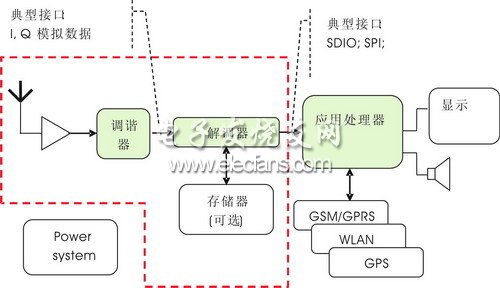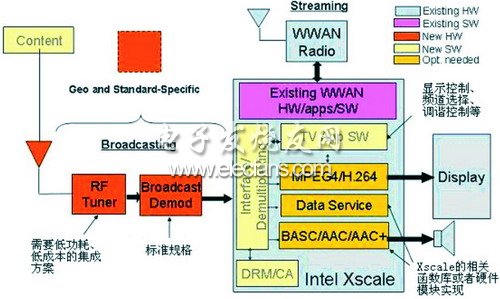Overview of mobile digital TV standards This article refers to the address: http:// At present, there are four main standards for mobile digital TV in the world: DVB-H in Europe, S/T-DMB based in South Korea, ISDB-T led by NHK in Japan, and MediaFLO in Qualcomm. China is independently researching and developing the terrestrial digital TV standard, DMB-TH, which is mainly aimed at the traditional terrestrial digital TV market and theoretically covers the support of mobile digital TV. Compared with T-DMB, DVB-H has certain technical advantages. The wider spectrum makes DVB-H flatter in the frequency domain and thus has better frequency consistency; QPSK adopted by DVB-H The modulation method has 3dB redundancy compared to T-DMB's D-QPSK; DVB-H's forward error correction technology (MPE-FEC) can bring 5~6dB gain; time slicing technology also enables DVB -H has lower power consumption (average typical power consumption of DVB-H terminals is generally less than 80mW, while T-DMB is generally more than 200mW). However, due to the early development of T-DMB and the support of well-known Korean manufacturers, it is more mature than DVB-H in terminal equipment, overall solutions and business models, and it has a dominant position in China's mobile digital TV market. Many mobile phone design manufacturers in China are conducting research and development of T-DMB mobile TV. It is expected that products will be available in early 2007. Mobile digital TV terminal From the perspective of application mode, mobile digital TV terminals can be divided into three categories: applications on notebooks, with emphasis on DVB-T; applications on mobile phones, with emphasis on DVB-H, T-DMB; applications for special devices (such as PMP). The focus is also on DVB-H and T-DMB. In general, mobile digital TV terminals contain four key components, an antenna, a tuner, a de-modulator, and an application processor. Figure 1 shows the architecture of a typical mobile TV terminal. Figure 1 DVB-H receiving terminal on mobile phone and PMP The part of the red border can be designed to be a separate module such as an SDIO card. Implementation of Mobile Digital Mobile TV Based on Intel PXA270 PXA27x overview The PXA270 processor is an integrated on-chip microprocessor for a wide range of high performance, low power, portable, handheld devices. Thanks to on-the-fly voltage regulation technology, frequency adjustment technology and proven power management technology, Intel XScale chips deliver industry-leading high performance, low power (MIPs/mW) performance. The PXA27X processor uses ARM architecture, V5TE instruction system, and ARM programming mode. At the same time, PXA27X processor provides wireless MMX integrated instruction set for audio and video processing, which greatly improves product performance within a certain power consumption range. Figure 2 PXA270 chip frame Intel's wireless MMX technology eliminates the need for additional processors or acceleration chips, which greatly extends battery life. Wireless MMX technology includes an advanced multimedia instruction set that enables customers to run on a wide range of applications while significantly reducing power consumption, bringing the performance of desktop PCs to the PXA27X's processors. Intel Wireless MMX technology was originally derived from the Pentium processor family, and many software developers have mastered and used these instructions to quickly develop 2D, 3D games, MPEG4 streaming media, and wireless codec technology based on Intel's cellular phones and handhelds. , digital TV reception and voice recognition applications. Intel Wireless SpeedStep technology was first introduced in the PXA27X processing family. This technology provides the ability to dynamically adjust power consumption and performance based on processor requirements. This new feature freely changes voltage and frequency while ensuring the necessary performance for complex applications, significantly reducing the power consumption of wireless handsets, increasing standby time and talk time. Xsclae Mobile DTV system Figure 3 is a simplified illustration of the framework of an Xscale-based mobile digital television system. Figure 3 Xscale-based mobile digital TV block diagram Conclusion Xscale-based mobile digital TV applications are just as hot-spot applications as GPS applications, and they are also very likely to be organically combined, together with PMP and mobile phone functions to form some versatile portable products. We have been working on the development and production of such portable products. For more specific information, please refer to the reference design scheme of Liod-DTV launched by Yidao Electronic Technology Co., Ltd. SHENZHEN YINZHIGUAN DIGITAL TECHNOLOGY CO.,LTD , http://www.yzgmusiccrown.com

